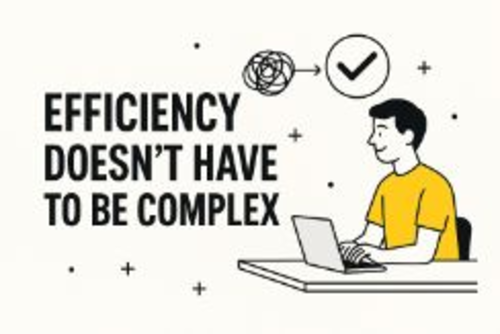In the fast-paced world of small business, efficiency is often seen as a complex puzzle—one that requires sophisticated tools, intricate workflows, and endless optimization. But here’s the truth: efficiency doesn’t have to be complicated. In fact, the most effective solutions are often the simplest ones.
Whether you’re managing a team of five or juggling multiple roles as a solo entrepreneur, embracing simplicity can unlock time, reduce stress, and boost productivity in ways that complex systems rarely can.

1. Complexity Is a Hidden Cost
Many small businesses fall into the trap of over-engineering their processes. Fancy software, layered approval systems, and endless spreadsheets might seem impressive, but they often create more friction than flow.
Every extra step, tool, or decision point adds cognitive load and slows down execution. Simplicity, on the other hand, removes barriers and empowers teams to act quickly and confidently.
Tip: Audit your current workflows. Ask yourself: “Is this step necessary?” If not, eliminate or automate it.
2. Simple Tools, Big Impact
You don’t need enterprise-level platforms to run a successful business. Modern cloud-based tools like Bukku and Xero help small businesses streamline operations by automating routine tasks, simplifying financial management, and improving overall workflow efficiency—without the need for complex systems.
The key is to choose tools that are intuitive, easy to adopt, and solve a specific problem without adding unnecessary complexity.
Example: Instead of investing in a full-scale CRM suite, small businesses can start with cloud-based solutions like Bukku and Xero, which offer streamlined contact management and built-in email automation—making it easier to stay connected with customers and manage relationships efficiently.
3. Clarity Drives Action
Simplicity isn’t just about tools—it’s about communication. Clear goals, straightforward instructions, and transparent expectations help teams stay aligned and focused.
When everyone knows what success looks like and how to get there, decisions are faster, collaboration is smoother, and outcomes are stronger.
Tip: Use one-page strategy documents or visual dashboards to keep your team aligned without overwhelming them with data.
4. The 80/20 Rule Applies
The Pareto Principle—also known as the 80/20 rule—suggests that 80% of results come from 20% of efforts. In small business, this means identifying the few actions that drive the most value and doubling down on them.
Instead of trying to do everything, focus on doing the right things simply and consistently.
Example: If social media drives most of your leads, prioritize a simple content calendar and automate posting rather than trying to master every channel.
5. Simplicity Scales
As your business grows, simple systems are easier to replicate, train, and scale. Complexity might work for now, but it often breaks under pressure. Simple solutions, by contrast, are resilient and adaptable.
Tip: Document your processes in plain language. This makes onboarding new team members faster and ensures consistency as you expand.
Conclusion
Efficiency isn’t about doing more—it’s about doing what matters, better. For small businesses, the path to growth and sustainability lies not in complexity, but in clarity, simplicity, and smart execution.
So the next time you’re tempted to add another tool, layer, or process, pause and ask: Is there a simpler way?